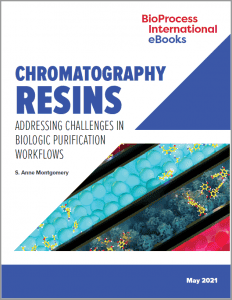eBook: Chromatography Resins — Addressing Challenges in Biologic Purification WorkflowseBook: Chromatography Resins — Addressing Challenges in Biologic Purification Workflows
May 18, 2021
 Although chromatography remains the backbone of downstream workflows, selecting appropriate technologies to optimize processes can be challenging. Numerous resin options are available, and the fact that most biologics are large, complex, and inherently unstable further complicates development of a robust workflow. Because chromatography processes can alter a biologic in ways that could impair its intended therapeutic function, investment in process development is critical. Techniques such as design of experiments (DoE) can be used to identify the best approach during process development. Areas of focus typically include reducing the number of chromatography steps, improving step transitions for better process economics, selecting resins that are salt and pH tolerant to improve stability of biologic products, and ensuring scalability of resins. Several factors affect chromatography resin selection, including required physicochemical characteristics and desired purity for final application.
Although chromatography remains the backbone of downstream workflows, selecting appropriate technologies to optimize processes can be challenging. Numerous resin options are available, and the fact that most biologics are large, complex, and inherently unstable further complicates development of a robust workflow. Because chromatography processes can alter a biologic in ways that could impair its intended therapeutic function, investment in process development is critical. Techniques such as design of experiments (DoE) can be used to identify the best approach during process development. Areas of focus typically include reducing the number of chromatography steps, improving step transitions for better process economics, selecting resins that are salt and pH tolerant to improve stability of biologic products, and ensuring scalability of resins. Several factors affect chromatography resin selection, including required physicochemical characteristics and desired purity for final application.
As this eBook explains, each resin has unique properties, and purification strategies often are divided into steps such as capture, intermediate, and polish. Resins used in each step must be selected based on whether they can overcome specific challenges presented by different biologics and deliver desired process economics, timelines, and purity, among other factors. Read on to learn about stage- and modality-specific criteria for chromatography resin selection, including recommendations for purification of plasmid DNA, viruses and virus-like particles, and emerging modalities.
Fill out the form below to read the complete eBook now.
You May Also Like





